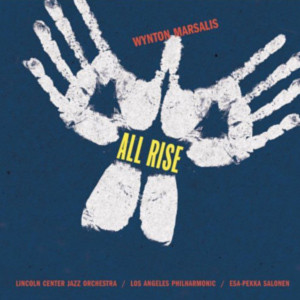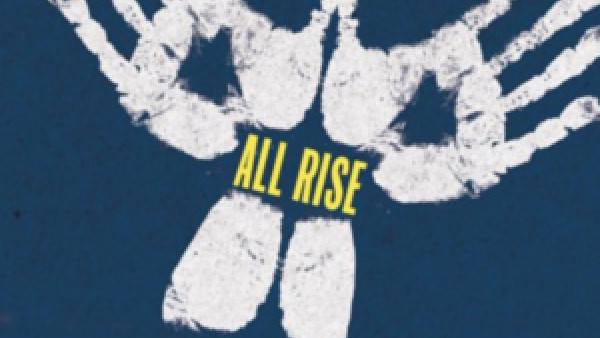All Rise: The freedom of jazz
The idea of a synthesis of Classical music and Jazz is nearly as old as Jazz itself — from Gershwin and Stravinsky through Bernstein, Brubeck or Jacques Loussier. But Wynton Marsalis, the outstanding New York-based trumpeter and bandleader, educator and composer from New Orleans, has a special approach. For the perennial problem of how to allow the improvisational freedom of jazz within a classical frame is resolved by a coolly crafted combination of jazz band — his own Lincoln Centre Jazz Orchestra — with a symphony orchestra and Gospel choir in a true spirit of partnership, with an eclectic mix of different styles and genres centred on the Blues. Originally commissioned by the New York Philharmonic in 1999 and recorded by the Los Angeles Philharmonic in 2002, the work was performed here by the LCJO with the London Philharmonic and the London Adventist Chorale under the command of Kurt Masur, at a capacity filled Albert Hall. The concert was given in aid of New Orleans Relief, the third leg in a five-concert UK première tour (following performances in Birmingham and Cardiff).
The piece, according to the composer ‘celebrates togetherness and ascendence in the context of the blues’ and twelve movements (based on the idea of a 12-bar blues) show how the freedom of jazz can be combined with the traditions of concert music, sectioned into three contrasting groups in a traditional fast-slow-fast arrangement. The final choral movement entitled ‘All Rise’ sums up the theme of the entire piece which addresses the ‘global community’ through the blues which Marsalis sees as ‘containing elements of folk music from all over the world and expressing the philosophy of acceptance of life’ — perhaps questionably, since one might want to consider the blues as an expression of a state of affairs inviting one to rise up against injustice and oppression. Yet the simple three-part form allowed one to focus on the really innovative aspect of the work, the inspired mixture of popular idioms, eastern scales and classical elements, embodying the idea of ‘togetherness’, a combination of disparate styles and peoples, not, as Marsalis says ‘in a world-music type of melange’ but keeping them distinct, and yet emphasising, through a myriad variations of blues, traces of their commonality.
At a formal level the work displays some of the features of the Baroque era, combining elements of the oratorio, orchestral suite and, most strikingly, the concerto grosso, in which the virtuoso concertino — the LCJO — is pitted in dialogue and combination with the larger symphony orchestra, with ingenious dovetailings of brass or woodwind. It is a very American work, one in which the joyful brilliance of the Lincoln Centre Jazz Orchestra’s many jazz idioms, interacts with the orchestra both as a classical and jazz medium. For example in the initial four movement section, the thrusting driving patterns of the music were infused with great energy and rich harmony, as in the overture ‘Jubal Step’. One movement begins with Mahlerian waltz, while ‘Wild Strumming of Fiddle’ is a Coplandesque ‘Hoedown’ leading to a fizzing fugato reminiscent of Ned Rorem. Many of the textures recall Bernstein’s swinging syntheses and big bands of the 40s and 50s; the orchestra often comments on and dovetails into the jazz soloists who then go off on their own; at one point the orchestra is also a brilliant big band all on its own.
There were many highlights to this exuberant performance in which the always lucid Kurt Masur seemed to be gradually skipping more and more to the LCJO’s beat and riff, and the audience increased in a warm responses to each new jazz solo sandwiched between orchestral textures. Most impressive was Marsalis’s own, in ‘Save Us’, sharing his inimitable trumpet playing which makes the instrument sound almost vocal, high in its register, swoops and glissandos and pure-toned high notes, shaped into a dreamy world of its own; and his always audible interjections into the lively tutti-choral movements added vital spice; there were several other notable solos, one for trombone ending on an incredibly pure high note, various sax solos and a witty duet for principal orchestral violin and principal cellist, accompanied by piano and bass. The piano solo was a fantastic display of musicianship, sophisticated and subtle in its blues harmony and extended phrases, while final limelight was reserved for the superb drummer who throughout was a fine partner to the team of percussionists of the London Philharmonic who visibly enjoyed their syncopated colours on various instruments including guiro, slapsticks and cymbals.
The singing of the London Adventist Chorale was riveting throughout, gradually increasing in presence from a short introductory movement to the solemn movements of the second main group. In ‘Save us’ a sprechgesang alto soloist shouts ‘Comfort me’ against a wall of groaning slithering chromatically in dizzy curves, creating haunting colours enhanced by Marsalis’s solo; it is followed by the fiercer ‘Cried Shouter Then Sung’, with screaming trumpet solos. Here Marsalis’s use of the ‘New Orleans Funeral Cadence’ (an almost prophetic choice in the wake of the recent devastation of Hurricane Katrina) added to the ‘affect’ of the music punctuated also by unusual tuba solos, while the choir shone in the final brilliant pair of movements to close this section, ‘Look Beyond’, with its upbeat Hosannas and a spiritual song ‘come back home’ in which five soloists of the choir (Tina Brooks, alto, Bobby Carr, tenor, Ken Burton, baritone, the choir’s Artistic Director, and Alaffia Maxwell, bass) displayed wonderful zest and style, the last an unbelievably high soprano solo (Jennifer Phillips), the inner intensity of which drew to a conclusion with spiritual passion and eloquence that affirmed the work’s underlying seriousness of purpose. Indeed the whole work, with its unpredictable phrase lengths and effects, rich and unusual harmonies, nuances of orchestration and dynamics seemed to channel the qualities of light musicality into a most engaging and profound artistic confluence of serious and popular idioms.
The third and final section (retained for the second half of the evening) featured dance movements including a slinky slow ‘Saturday Night Slow Drag’ and faster dances like the bossa nova, before the thrilling final tutti chorus ‘All Rise’. The movement begins with a soloist repeating ‘all rise’, with ensuing lively choral textures leading to an uplifting gospel song ‘Listen up and hear my song’, to which the jazz orchestra adds a final coda in Dixieland swing, a section that was repeated as encore after the enthusiastic applause from the audience, who joined in some warm hand clapping. As an additional treat Kurt Masur remained on stage for a beautiful jazz number by the LCJO, led by a beguiling Marsalis solo, in which he coaxed some husky, blues inflected tunings, notes at pianissimo levels, evocatively silhouetted in profile, as artist and instrument seemed for an extended moment to fuse into a single item. It was just the right note to leave.
– by Malcolm Miller
Source: Music & Vision


